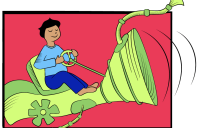How do you tell the different between when government programs overlap and duplicate each other versus when they complement and reinforce each other in a collaborative network? Is this just a difference in rhetoric or in reality?
This is the underlying theme of a new report by Congressional Research Service specialist Fredrick Kaiser, in “Interagency Collaborative Arrangements and Activities: Types, Rationales, and Considerations.” Given the recent big push by Congress to deal with overlapping programs, and recent reports by the Government Accountability Office, it is quite timely.
Kaiser doesn’t draw a line between duplication/overlap and mutually reinforcing/collaborative programs, but he does lay out a framework for understanding the different kinds of collaborative arrangements because there is no commonly accepted definition. He frames (and offers definitions for) six different types:
- Collaboration, an arrangement which relies, to a substantial degree, on voluntary or discretionary participation among the members, who are relatively equal or at least have parity in such an activity and arrangement;
- Coordination, an arrangement in which a lead agency or officer directs an operation, project, or program among one or more other agencies;
- Merger, an arrangement which merges or transfers all or parts of different agencies or their authorities, jurisdictions, personnel, and resources on a permanent basis to another organization, either a new or existing department, agency, bureau, office, or other entity;
- Integration, an arrangement which brings together relevant parts of agencies on either a long-term or a temporary ad hoc basis, to carry out a particular operation, project, program, or policy; these endeavors, unlike mergers, involve nonpermanent transfers of personnel, resources, or authority among relevant agencies;
- Networks, an arrangement which involves the federal government and all or several other levels of government: federal, state, local, tribal, or, in some cases, foreign countries; and
- Partnerships, an arrangement which features public-private partnerships, with the public sector entities extending from the federal government to state, local, or tribal governments, as well as, in some cases, foreign governments; and with the private sector involving different types of entities: non-governmental organizations (NGOs), not-for-profit organizations, for-profit companies and firms, government-sponsored enterprises, and government-chartered corporations.
He says each type used has an underlying rationale and expectations, ranging from “reducing policy fragmentation,” and “mitigating competition” to “enhancing efficiency and effectiveness” and “streamlining and improving congressional and executive oversight.” His report is heavily footnoted with examples and reports from across the government, such as homeland security, intelligence, emergency management, and health care. He even reaches back to a 1937 report, “Senate Select Committee to Investigate Executive Agencies with a View to Coordination.”
He concludes that most collaborative efforts are context-dependent and “differ in structure, organization, authorities, purposes, size, scope, scale, life-span, and expectations.” As a result, their effectiveness has not been systematically documented.
So, there’s no answer as to whether multiple, overlapping programs are an opportunity for collaboration, or an opportunity for elimination!





Interesting report, thanks for sharing!
Agreed, intersting and lots of opportunities to be gained.
In our government, we have a “deputy heads breakfast” every week (or something like that). “Deputy head” includes almost everyone who heads up a federal agency/department/ministry/board/commission/etc. I gather the list is somewhere around 65-70 individuals. The breakfasts are for the purposes of relaying information from cabinet or head of the public service, but I gather these are also opportunities for deputy heads to network and find out what’s on the drawing board in those other organizations they share common interests with. In a way, it’s much like the Monday morning “assembly hall” meetings you might have had in high school, where the announcements of the week’s events, and maybe last week’s achievements are made.
As useful as that can be, I suspect it is one thing for the agency heads to be in the loop, and another for the staff below them to be. Obviously, with an organization so broadly dispersed, and so large as a federal public service, you can’t just pack everyone into the same space like packing students into a gym or auditorium, So one needs to be able to rely on people at or near the top communicating about areas of shared interest or activity so that people can stay in touch, collaborate where possible, and prevent needless overlap whenever feasible..
This analysis leaves out the possibility of competition, in which programs don’t duplicate services or complement one another but occupy different space. Think “market share.” Monopoly is not good for consumers of government services any more than it is for consumers of goods and services produced by private enterprise. The only useful benchmark is a true alternative – which won’t exist if we eliminate all duplication. Moreover, we need the flexibility to choose between them to serve as an incentive for the competing entities to improve.
Hi Steve — I don’t think the author intended to cover all forms of possible government involvement in a policy area, but rather those where collaboration would be a preferred approach. Market-based mechanisms are a different tool and, as you point out, can serve a useful purpose.